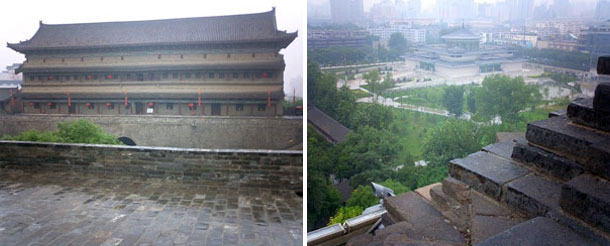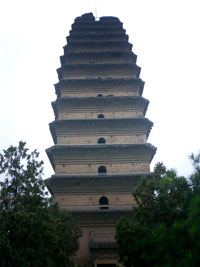The Daily Telegraph - The march of Xi'an's Terracotta Army
September 1, 2007
As the British Museum prepares its 'First Emperor' exhibition, Michelle Jana Chan recommends a visit to Xi'an, the city that inspired it.

The Chinese army is invading London. On September 13, the British Museum will be opening its doors on a much-vaunted exhibition called The First Emperor: China's Terracotta Army.
Anybody who hasn't yet travelled to Xi'an, China's ancient capital, will have a chance to see some of the contents of Emperor Qin's tomb, including life-size terracotta soldiers, strongmen and acrobats. It is the largest collection of the first emperor's afterlife artefacts ever to leave China and - another first - it will be displayed in the museum's elegant Reading Room, in the heart of Norman Foster's expansive Great Court.
Stunning as the British Museum exhibition looks set to be, nothing can take away from the spectacle of seeing the Terracotta Army in situ. Rather than just the 12 despatched to London, there are some 8,000 warriors on show in hangars outside the city of Xi'an.
Many lie broken, but more than 1,000 are restored and lined up in battle formation. Emperor Qin wanted to be well protected after death, when he planned to rule the universe remotely from his tomb.
It is partly the proportions of Qin's tomb that makes Xi'an's landmark heritage site such a draw. But look closer and the drama is in the detail, too. Each of the faces of the soldiers is unique, be it through a raised eyebrow, the set of the lips or the twist of a moustache. The sculptural work is as impressive as the size of the site, and it is seeing the warriors en masse that gives a true sense of that scale.

While the Terracotta Army is the main reason for visiting Xi'an, there are many other draws, including world-class museums and the 14th-century city walls. After Emperor Qin's rule, the city remained the political heart of the country and a hub of creativity for more than a millennium.
When Britain was in the Dark Ages, Xi'an was the one of the world's largest cities and the starting point of the Silk Road. Thirteen empires have had their capital here.
For all its grandiose history, my strongest memory from the time I lived in Xi'an is of its street life. Everyone used to head out to the street in their free time, partly because nobody had enough money to create a comfortable home or buy a television set. Social life took place right outside our front doors.
It was out on the pavement that I took lessons in tai chi each morning. In winter, I met friends to share spicy noodles at street eateries; in summer, we sucked on wedges of watermelon to keep cool. The fruit-sellers used to sleep atop melon mountains piled 20ft high on the pavement.
I remember Aiguo the cobbler fixing shoes on the street, the bicycle-menders at every corner and the elderly walking home backwards (to restore the chi they had lost by walking forwards in the day). My experience had nothing to do with dynasties or ancient history, but the year I spent in Xi'an offered a fleeting glimpse of a past era in China.
More recently, one wet afternoon earlier this year, I climbed 15 storeys up the Little Goose Pagoda, a cream-coloured monument built in the eighth century. From the top I could see how radically modern the city had become.
Where there were once great swathes of hutongs, the traditional neighbourhoods of squat houses, flicked roofs and round, moon-shaped gates, there were now skyscrapers, white-tiled shopping malls and hotels with flashing neon signage. The moving mass of bicycles had been replaced by ring-roads of circuiting cars and taxis.
But the race to modernity has not meant that Xi'an has forgotten its long and profound history. Instead it has found new ways of presenting it. Immediately south-east of the pagoda, I noticed a sparkling building topped with a glassy rotunda and surrounded by lotus-flower ponds. This was the newest attraction: Xi'an Museum.
Word was clearly not yet out on this place. Corridors were quiet. Labelling was only half done. Nobody I met in Xi'an knew anything about it. I had 5,000 years of history to myself: three floors of some of the finest treasures I had seen anywhere, from Buddhist icons to jade swords and ancient bronze vessels. If a museum of this stature had opened anywhere else in the world, there would have been a serious fanfare.
I made one more discovery on this trip: the Museum of Han Yangling, another impressive tomb on the outskirts of Xi'an. While two million people a year visit the Terracotta Warriors, only a fraction of that number comes here.
Rather than attempting to accommodate the massive ego of one man, this tomb was built for a family from the Han dynasty, which ruled a few centuries after Emperor Qin. There are terracotta soldiers here but, at just half the size of those guarding Qin, naked and armless, they are less fearsome.
In their prime, their movable arms were made of wood and they were clothed in silk, since disintegrated. Along with these pottery figurines, the tomb also holds thousands of sculpted animals: pigs, chickens, goats, cows and sheep, intended to ensure the Han clan had enough to eat. Again, the attention to detail is astonishing, as is the diversity of the tomb's contents and the sense of peace.
Undoubtedly, Xi'an will continue to offer up revelations because the city is surrounded by tombs from 11 dynasties, many still unopened. Even Emperor Qin's actual burial site remains sealed. Some believe disturbing the founder of China would bring bad luck. Others want to test the veracity of the legends: of underground palaces encrusted with precious stones and rivers of mercury - a kind of subterranean Xanadu.




